May 20 - 26, 2018: Issue 360
David Henry Lyall PSM ESMM FAIB
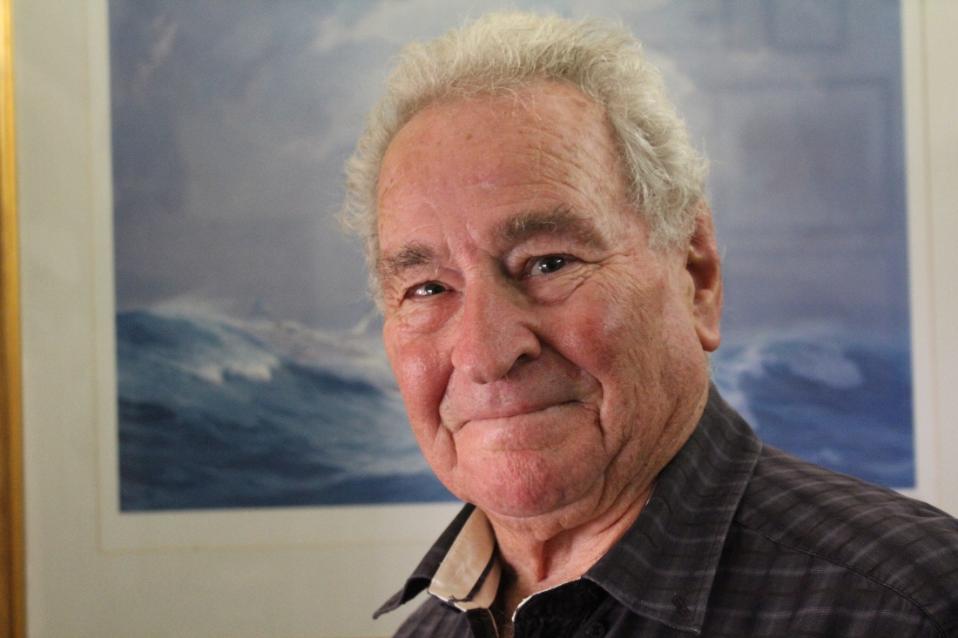
David Lyall has been investing in the Pittwater community for decades. He’s an extraordinary individual whose works would fill volumes. Not that he’d ever let you know. His input into Bilgola SLSC, Avalon Sailing Club, Marine Rescue NSW and the NSW Rural Fire Service spans the changes and challenges these organisations went through.
He loves local History, he loves building beautiful things with wood, he loves sailing, his wife and three sons - but not in that order.
He was seconded to Pittwater Council when that was formed and is rightly proud of the achievments, such as the MLAK key, that came out of a two year old local government organisation.
This is a clear case of still waters running deep: thank you sir for allowing us to share a small part of a rather large record.
Where and when were you born?
I was born at North Strathfield on the 3rd of March, 1933.
I started of in what was called Corey avenue and then we moved from there around to Cumming avenue at Concord, which was right alongside the Concord Golf club, which was very handy for picking up golf balls that came into the front garden.
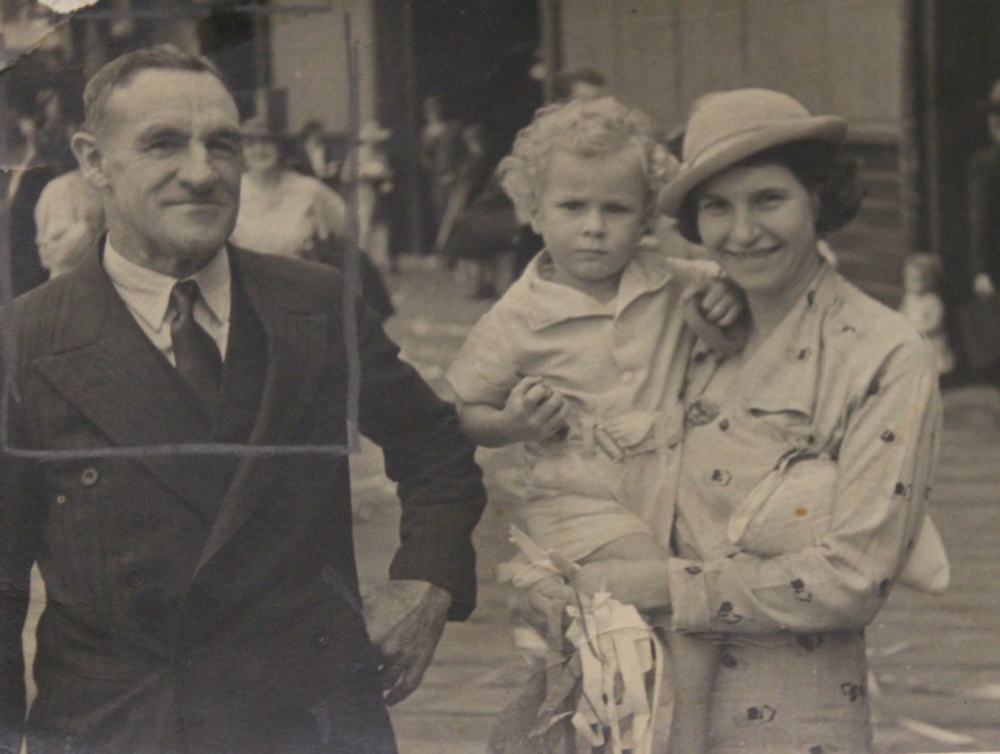
David with his mum and dad
I went to North Strathfield public school and from there was sent to Shore over at North Sydney. to get there at that stage was a train trip from Strathfield to North Sydney, which was only 20 minutes then and a lot better than changing trams to go to Newington.
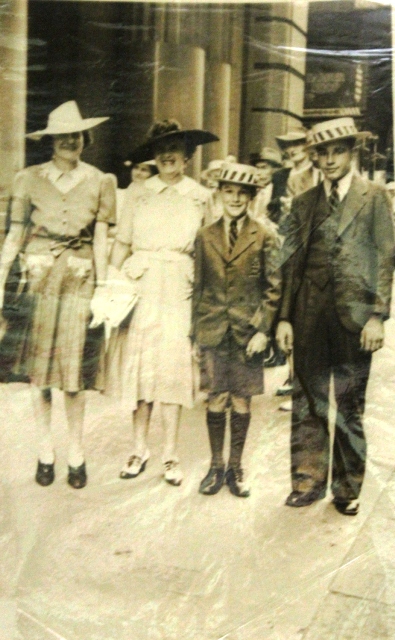
My mother was great friends with a lass that she’d worked with whose husband owned a house at Palm Beach and we stared holidaying at Palm Beach in the early 1940’s. That home was a place called ‘Arcadia’ which I’ve done a presentation on for the Avalon Beach Historical Society. Arcadia then became Bear Matthews, the Hideaway Restaurant, and it’s still there as a private home.
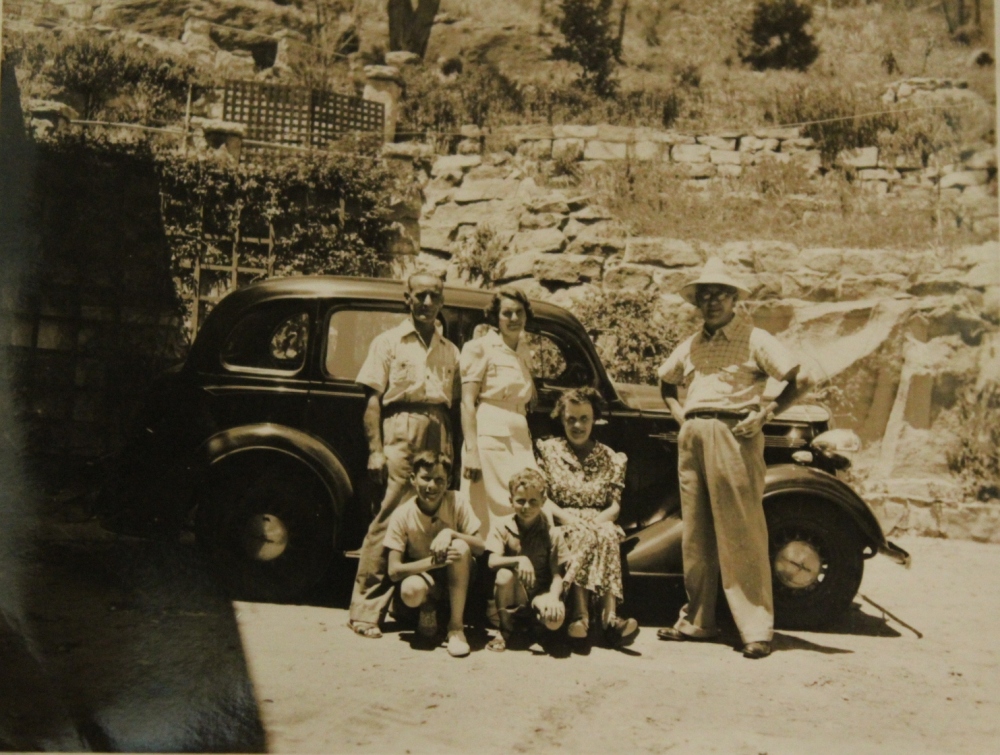
This photo shows Ern Verey, who owned the car, my mother and father, two of us boys and Mr. Verey’s wife. Ernest Verey was a tailor in King Street, Sydney and Arcadia was his weekender at Palm Beach. In that era being a tailor in King street was pretty lucrative.
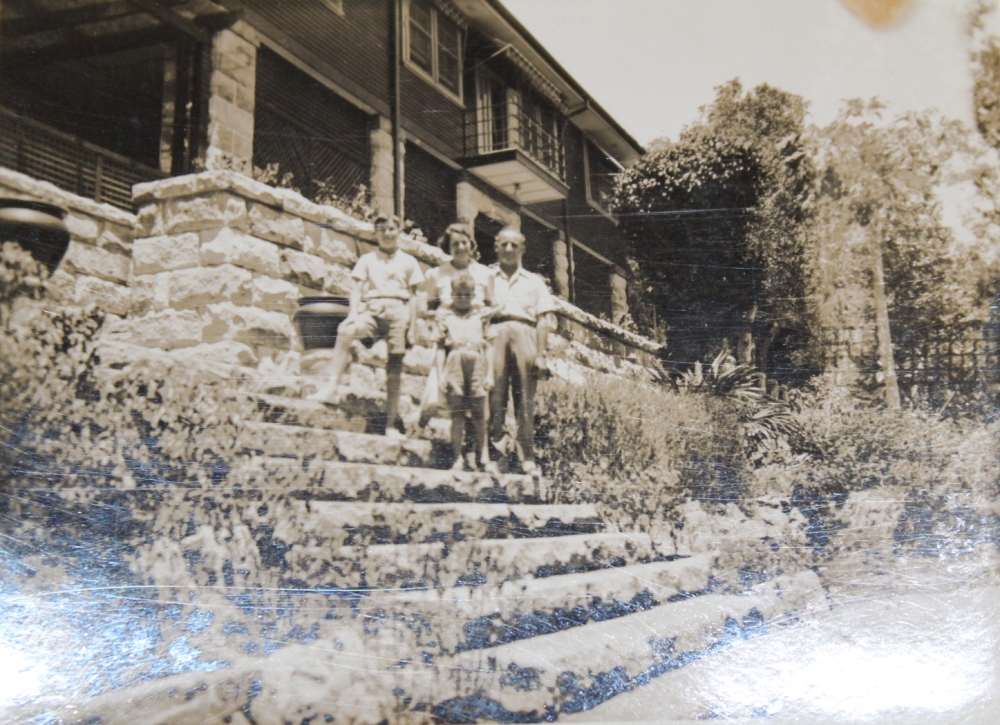
Arcadia, Palm Beach
At the same time my eldest brother Donald, because of his friends at Shore, became a member of Palm Beach Surf Life Saving Club. He was there mainly because he was a very good runner and footballer, actually representing New South Wales in Rugby Union during the 1950’s. Donald was also a very keen sporting shooter and became President of the Sporting Shooters Association and consequently went away with the Olympic team to Mexico.
His powers of running were very important to Palm Beach Surf Club and so they would actually drag him up and down Palm Beach pool each year to ensure he qualified for his swim each season.
Donald did want to serve Australia during WWII but as that was just finishing he wasn’t needed. He did a few odd jobs and then went back to university, theoretically to do accountancy but he actually did first, second and third year football and then he joined the family firm.
The family firm, at that stage, required one of us boys, with no ifs or buts or maybes, to go into that firm. The firm was called Harry Leslie, butcher’s suppliers, and started in 1918. That firm was commenced by my aunt, a Scottish spinster. Because it wasn’t polite for women to be in business in those days, they formed Harry Leslie 50-50 with Aunt Jenny, a Scottish spinster with Harry Leslie, a Jew.
That firm prospered for many years. And that’s the story of how we came to Palm Beach.
We had a great time down there, it was all still dirt roads, double decker buses all the way to Palm Beach in those days. I recall we would go up to the top of the hill at Palm Beach to be plane-spotters for Japanese aircraft.
We didn’t see any.
In 1949, due to my friends at Shore, I ended up at Bilgola Beach for the school holidays at Christmas. In December we were on the beach and were approached by a couple of locals; ‘do you want to join a surf club?’.
So instead of going to Palm Beach I became a foundation and original member at Bilgola.
Bilgola started in 1949.
I started off as a junior, then Gear Steward, Captain, President and Life Member.
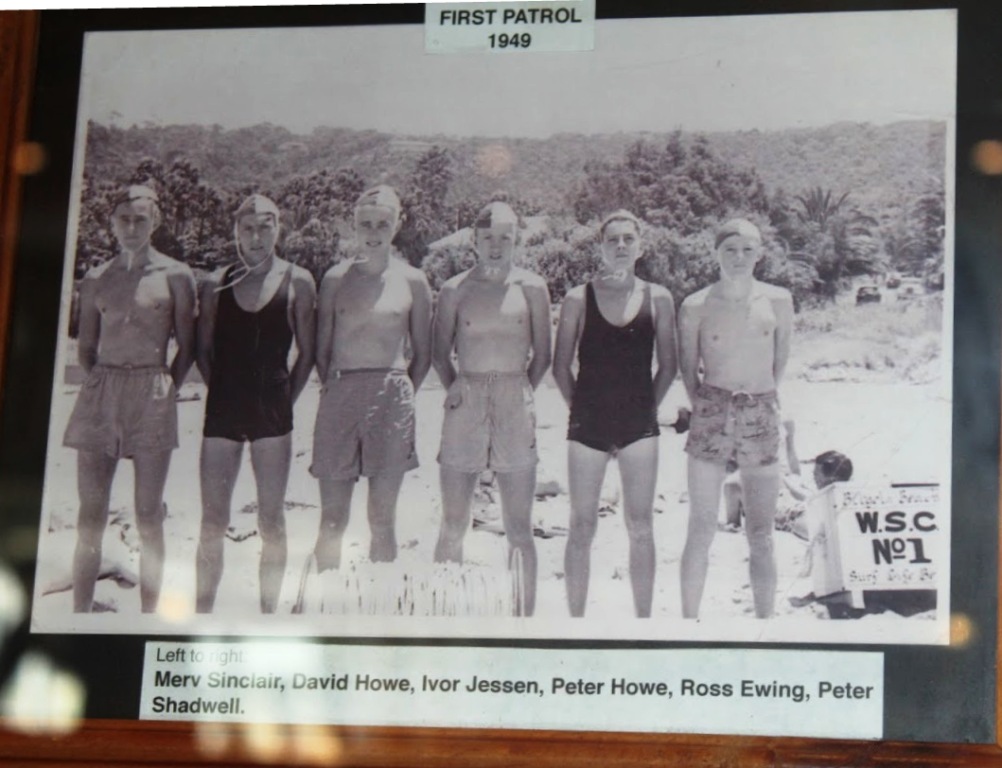
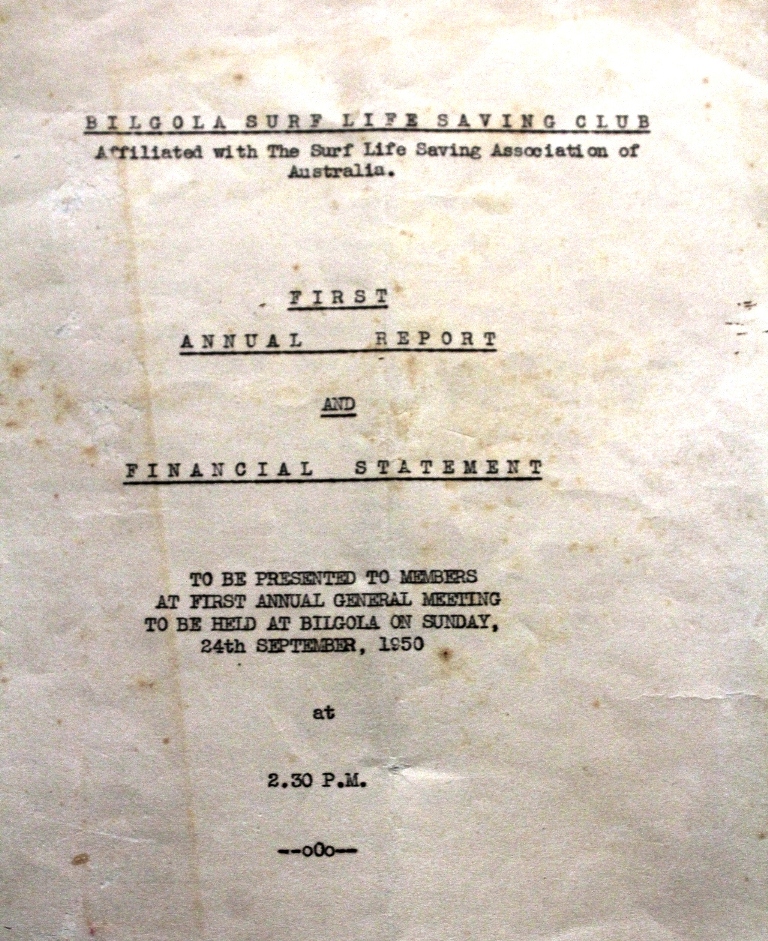
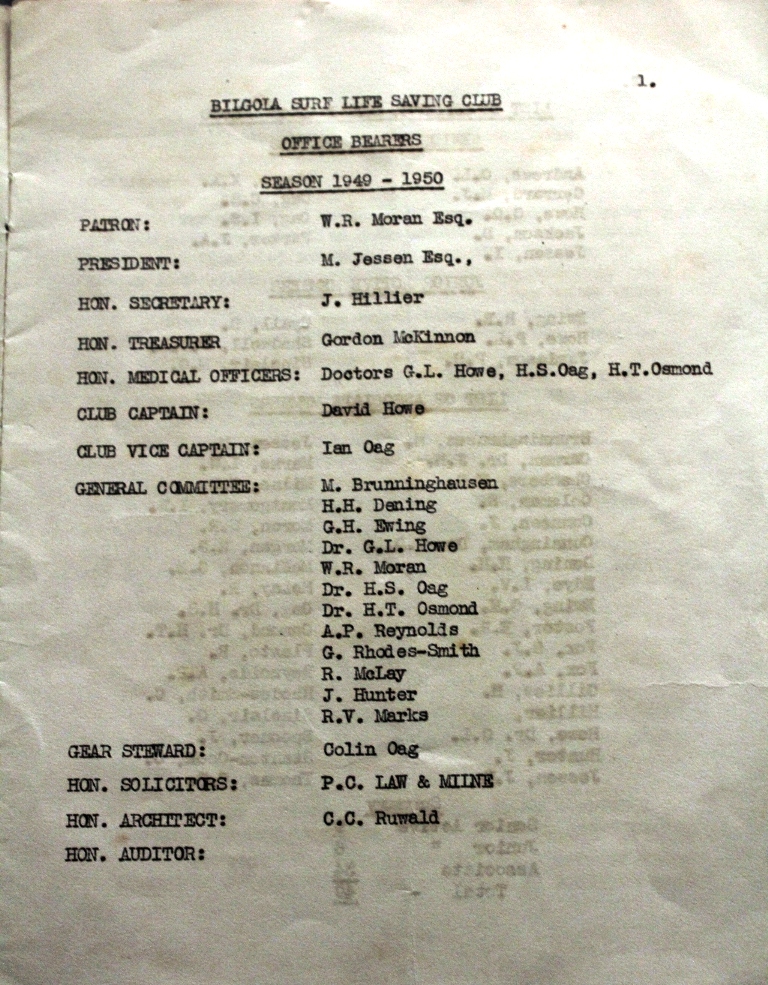
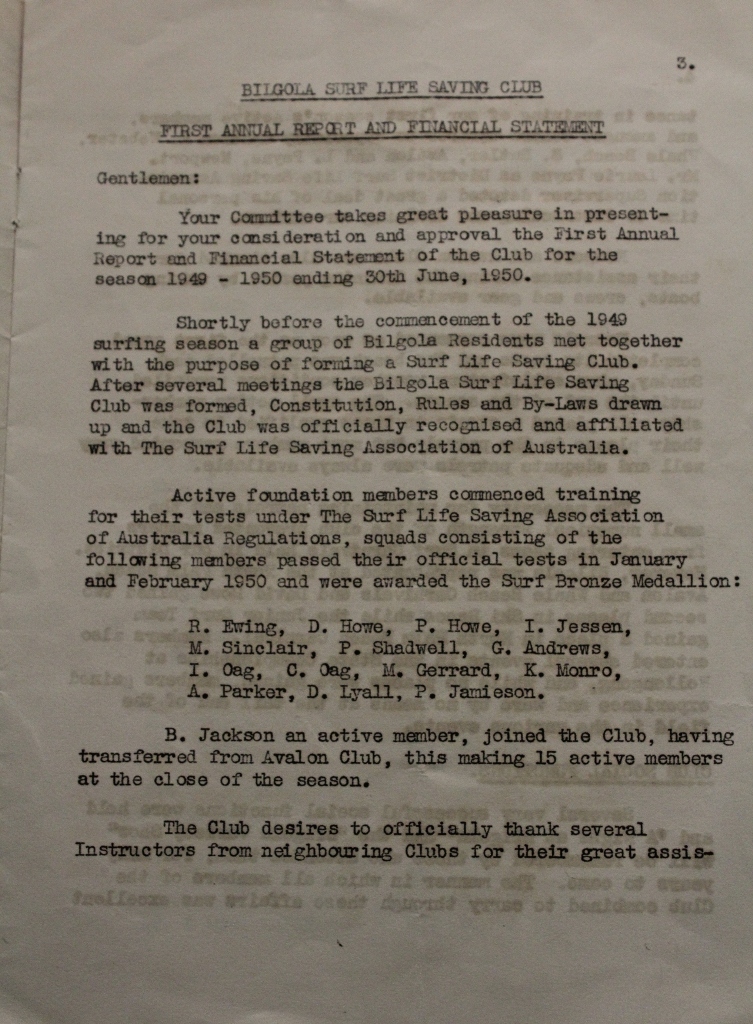
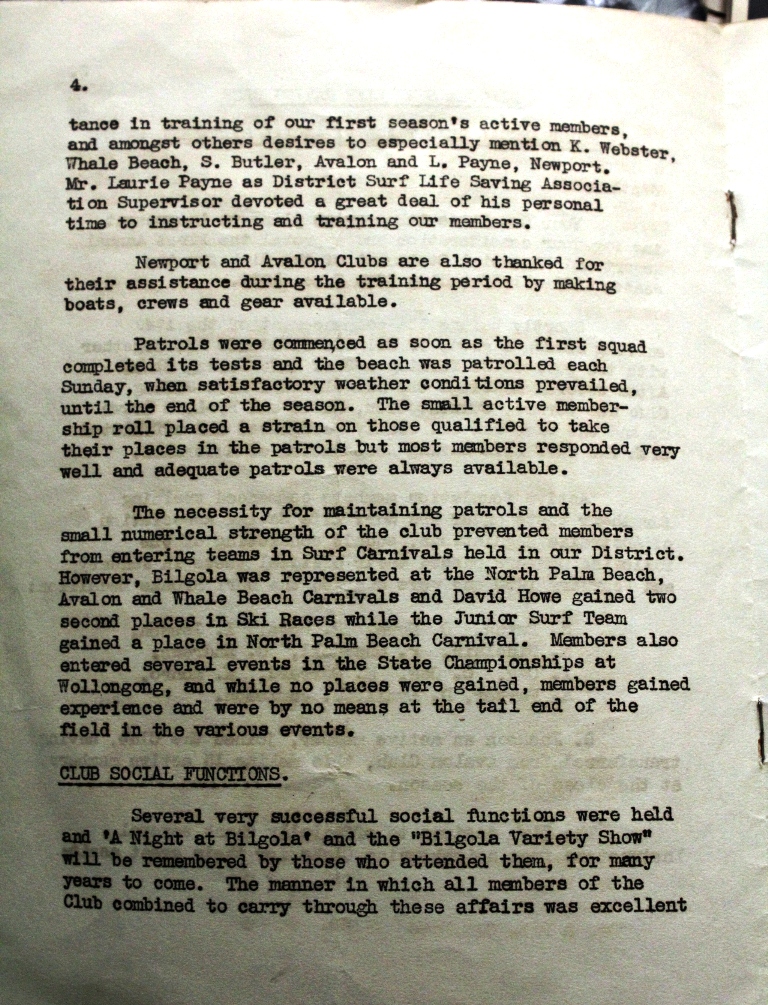
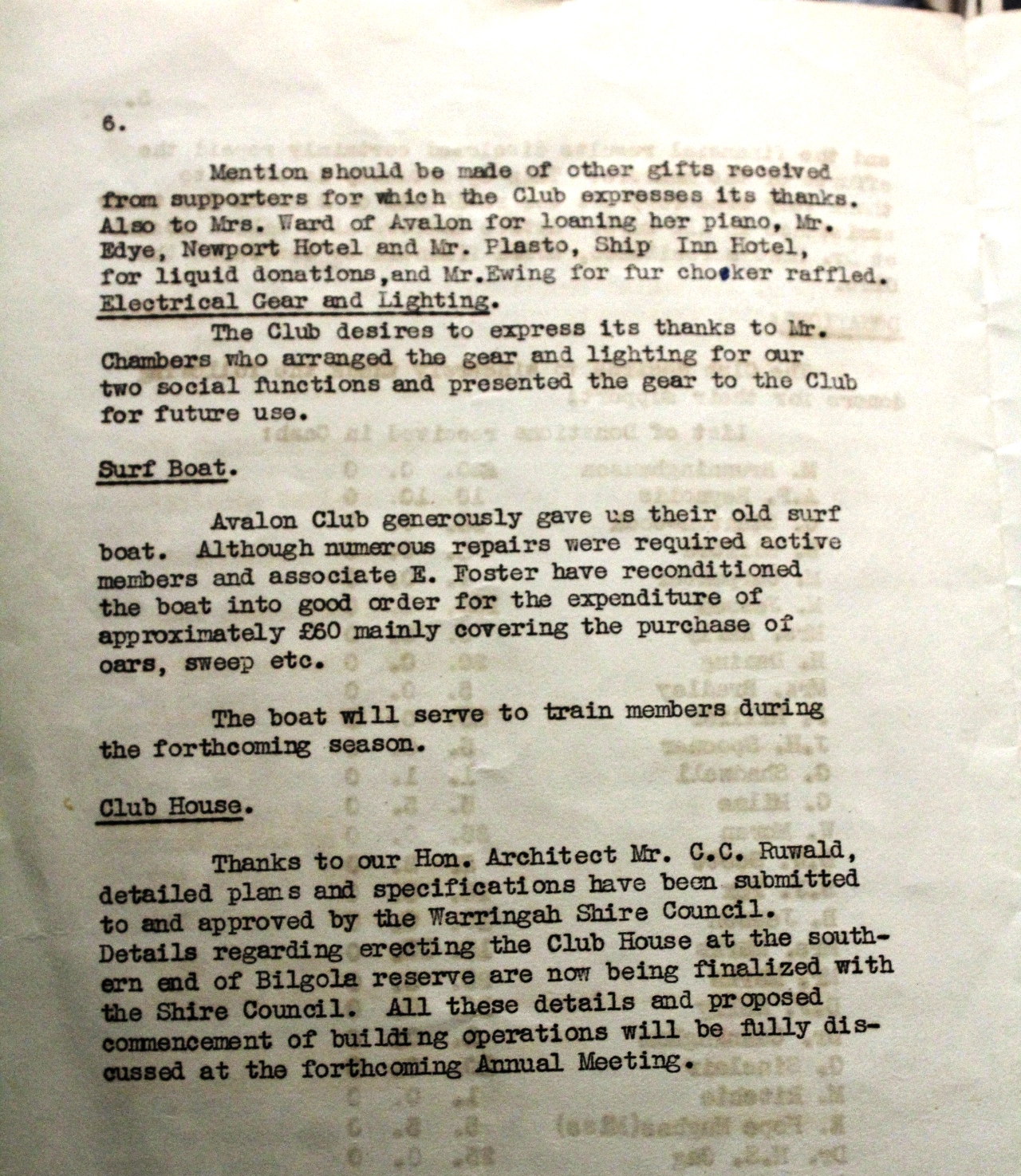
Bilgola SLSC's 1st annual report
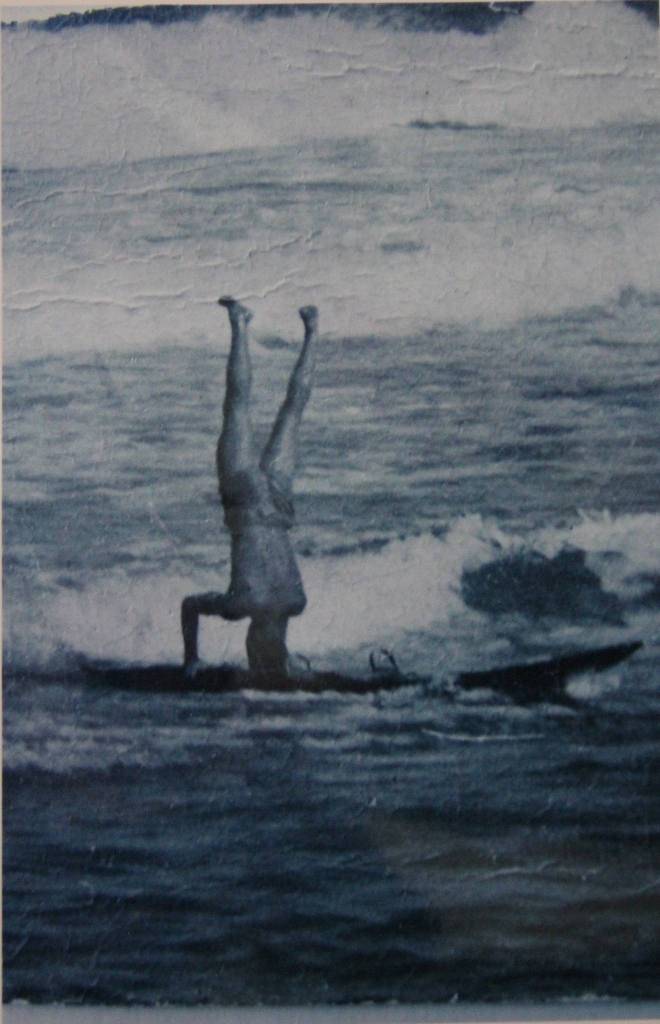
David at Bilgola - surf ski riding!
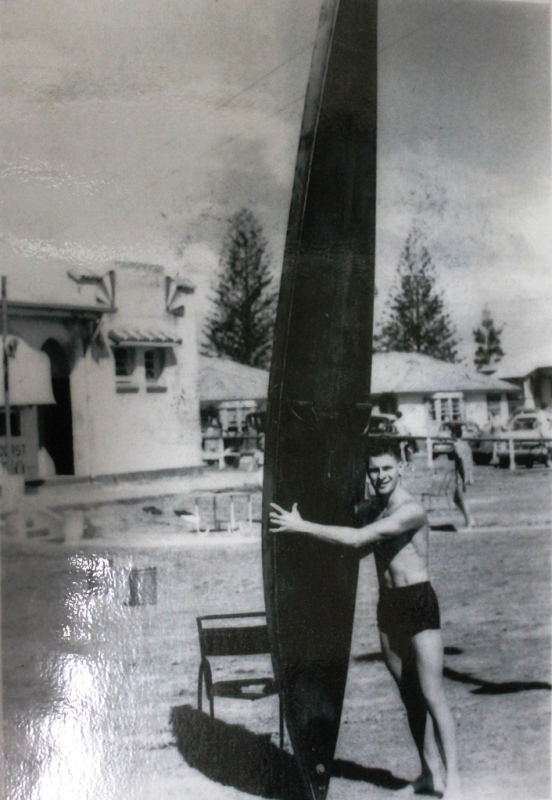
At Coolangatta in 1954
You were President at Bilgola from 1961-62 then again from 1964 to 1971, a fair while. What happened during your presidency?
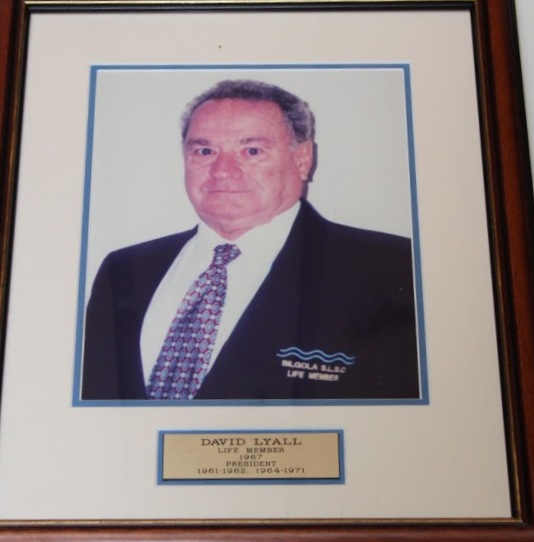 It was a case of running a surf club and keeping all the various members happy.
It was a case of running a surf club and keeping all the various members happy. When I first started we ran a lot of functions at Bilgola. We would close off Allan Avenue. We held concerts to raise money. We even sold hot water on the reserve to people coming in for the day for picnics – all to raise money for the club.
The gear at the club was at that stage stored in the garage of the Dr. Oag family, one of the families who had a house on the beach. Their sons Colin and Ian were original members.
After that we had a tent for storage in the laneway that went down between Bilgola House and the beach. Then Avalon surf club gave us a surf boat, which we affectionately called ‘Irene’ and it was decided we needed a clubhouse. An architect was engaged, pro bono.
In 1952 the lady who owned Bilgola House offered that premises and its site, plus the land all the way back to the Serpentine, for 18 thousand pounds. The committee of then decided ‘why should we spend all the money we’ve made, plus borrow more, when the council is going to give us some land over on the reserve and we can build a clubhouse there.’
So the then Warringah Shire Council of those days very graciously put two pegs in where the clubhouse could be built. The pegs were placed right against where the club’s barbecue currently is, on that lawn, and along the cliff-face. Luckily, two members, unknown, got slightly inebriated one night and went and quietly moved the pegs to something that wasn’t under the cliffs.
One of the members, Jim Robinson Scott, then borrowed a bulldozer from his firm and bulldozed the site of the present clubhouse.
At that stage there were two tradesmen in the club, Syd Fischer and myself. Fortunately all the other members were so enthusiastic we built the bottom half of that clubhouse ourselves with the help of Midge Gonsalves, the stonemason from Palm Beach.
For the second part we let a contract, which was the top floor, and then it was duly opened – which you have published the newspaper records of.
In those days a night at Bilgola on New Years Eve was big. Over a thousand people would turn up.
There were some funny occasions among these. As mentioned, we would close off the reserve and collect money from people coming in. A lot of people would still try and get in without paying, gate-crashing, and would come down the drain that ran beside Bilgola House. We had a couple of, shall we say ‘larger’ type of members, at the end of the drain ready to greet them. You could hear them coming.
I was working at a hotel over at Gladesville then, as an apprentice carpenter, and we were renovating that hotel. We used to get all the beer from there. At one stage, when we were demolishing the public bar, I measured off part of the bar, cut it, had the club truck come, loaded that on, and that became the bar at Bilgola for many many years.
The club had always held the premise in all of its fundraising works that it would do something for the club and it would do something for the community. We knew we must always have an interest going forward, or ahead, to keep members occupied and engaged in what we stand for.
So we decided to build a swimming pool.
The idea then, as the old swimming pool at Bilgola was right around the rocks and closer to Newport, it was right out on the rockshelf.
We looked into that and decided that the rocks above where we wanted to place it were unstable. We decided we could knock down those rocks and use these to build a wall around the pool without even having to touch the bottom of the pool.
The council then got involved and instead of taking that easy way out they let a contract for a firm who decided to use the rubble from the expressway approaches to the Harbour Bridge to build it. The club helped finance the pool.
So this was another achievement of club and community working to get something in place that would work going forward.
The other thing we did when we started that club was to put the facilities in that enable the Avalon-Bilgola Swimming Club to commence. This great club still exists and still have their premises within the club building.
Have you seen those photos John Stone took the day they brought down the cliff face to keep the pool safe?
Yes. That was a bit of a fuss over nothing. We sat up on the north headland at Bilgola to watch it, expecting something big and dramatic, a large explosion, and it was a bit of a fizzer.
The next extension for the clubhouse went out the southern side and this was financed by the council, and pushed through by one of the councillors who then spent a little bit of holiday time out at Long Bay.
I designed this. You may know it has a very obtuse angle at one side. This was put in place so that we could then go out to the east and make a full horseshoe structure for the clubhouse. Those plans are still in everybody’s mind and we hope to get around to it one day.
In between times, in 1958, I went away to Canada for a year. The idea was to go to Canada to make enough money to tour the world for four years, just as a backpacker. My best mate at Bilgola, Peter Howe, who I used to paddle a double surf ski with, didn’t want to go. Another chap, David King from Avalon, did though, so off we went.
The two of us went on a vessel called the ‘Lakemba’, which was a cargo vessel. It took us 48 days to get to Vancouver.
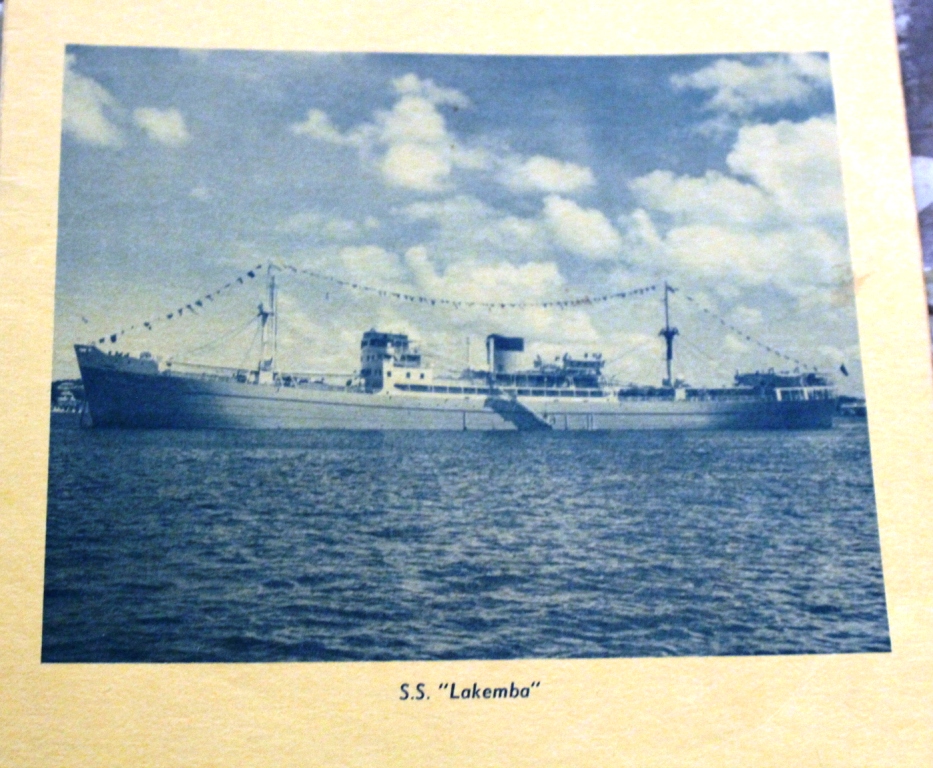
Voyage on the S.S. Lakemba - April 16 to May 23, 1958
When we arrived I very naively thought I’d just get a job in the Building Industry, as I had all the qualifications, only to find on arrival that there was a depression and there were no jobs available.
I went to the Canadian Red Cross and ended up doing a three day course at the University of British Columbia and then got a job for the whole Summer as a Lifeguard Swimming Instructor at Ucluelet Tofino on the West Coast, of Vancouver Island. This is now part of the Pacific Rim National Park. It was one of the best jobs I’ve ever had.
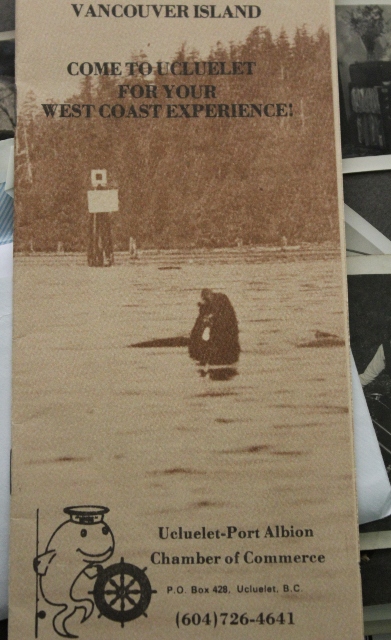 The funny thing was, when I went for a job in building they showed me a list of names. I placed on my on it and asked ‘what happens now?’ – ‘your name goes on the bottom and when the bloke at the top gets a job, up yours goes.’
The funny thing was, when I went for a job in building they showed me a list of names. I placed on my on it and asked ‘what happens now?’ – ‘your name goes on the bottom and when the bloke at the top gets a job, up yours goes.’At the Red Cross they brought out another list of the jobs that were available. Being naive I went down the column to pick out the one that paid the most money. All the Canadian kids were going down the other list looking for indoor heated pools. I ended up in the Pacific. I was surprised when I got home that I could father children.
I ended up teaching about 400 children and 68 adults to swim. I realised soon after I got there that this was, then, a very impoverished area – the only industries they had were logging and fishing. They had put all their money together to employ me, plus they had arranged for the local logging firm, MacMillan & Boedell, to put me up in the logging camp.
So I lived in the logging camp and ate with the loggers, which was quite an experience. There were no roads. To get there my car was put on a freighter from Port Alburnie and taken around to Ucluelet.
I realised just how generous these people were, and so instead of just teaching the children during the day I started teaching the adults as well. I made sure I did a lot more than what I was being paid for. To go back 20 years later and walk into a room or an office and have somebody say ‘Dave Lyall! You taught me to swim!’ - that’s nice.
They were lovely people, lovely children.
Dave King had left a girlfriend behind here. She followed him on the next boat. He said to me, ‘Dave, I can’t go touring anymore. Judy has come over and we’re going to get married’.
We had Letters of Introduction for England to go to Portsea lifeguarding; I had another to go and see the queen’s Horse guards, all sorts of Letters of that kind.
So I finished the year and thought ‘what am I going to do?’. I decided I’d drive on a sightseeing tour and spent ten weeks driving around Canada and the United States in a two door Tudor car. It was a great ten weeks, beautiful scenery, then sold the car and flew home.
So you were already qualified in which parts of the Building Trade prior to getting to Canada?
I was qualified in my Trade Certificate and I also had my Building Forman Clerk of Works Certificate. I did seven years at Meadowbank Tech, Sydney Tech and Lidcombe Tech.
I was doing four nights a week at these places. I’d left school prior to getting my Leaving Certificate so I did this of a night time while doing all the other work.
Wasn’t 1956 also when you witnessed the new surfboards at the Avalon Carnival?
Yes, that was just prior to going to Canada. In 1956 they had the Olympic Games being hosted by Melbourne and Surf Life Saving ran a concurrent carnival at Torquay in Victoria.
The USA Team brought out Hawaiians who did two carnivals here in Sydney – one at Cronulla and the other at Avalon. This was a normal surf club carnival which then was just the R&R, the running, boats, skis, etc..
What had happened with surfboards is that they kept getting longer as these were used in racing where they went out, went around the buoy and came back in again. The length of a board governs the speed that it will do; the longer the board, the faster it will go.
So surfboards had got up to 19 and 20 feet long.
The Hawaiians had brought their little boards with them. After the carnival they put on a display at the southern end of Avalon Beach.
Doug Jackson, who was a furniture manufacturer, Jackson Furniture, and I were there watching it. We looked at each other; ‘we could build those’.
We went back to his factory that week and built two surfboards. Took them down to Bilgola, rode them. Ross Renwick, also a Bilgola habitué in those days, said they looked and floated like doors.
But, they were so popular that we sold them that afternoon. We went back to the factory, built another couple. We ended up building a few of them. These were made with plywood stringers, rails and plywood top and bottom. They were hollow.
This became so frenetic they we ended up just band-sawing out all the pieces and selling them in kit form. People would buy these kits and make them themselves.
Jack Wilson and Alana Wilson up in Ruskin Rowe and Tony Clunes were some of those who bought them and made their own boards.
Doug and I looked at it and thought, ‘ok, the evolvement of this idea is going into foam, covered with fibreglass’. Neither of us wanted to get involved with fibreglass – so he went to furniture manufacturing and I went back to building.
That year, 1956, was also my final years of Tech. work. We drove down to Melbourne, competed, flew home and did the final exams, flew back to Melbourne, competed again, then came back to Sydney again. It was pretty hectic.
Torquay was quite an amazing place for a carnival. One of the funniest events I recall from that is when the officials from Surf Life Saving set out the corner pegs for the March Past - at low tide.
Then the tide came in.
Have you ever seen a fully kitted Scottish Pipe Band marching up to the base of their kilts in salt water? It wasn’t a very popular decision that one. That was a big time carnival though.
In between times, Jim Robinson-Scott, the bulldozer gent, bought a yacht and asked who wanted to go sailing. Another chap, George Andrews and myself volunteered to help him.
We started offshore racing with Jim.
What was the name of the yacht?
The first one was called Valima, then Poitrel I, named after the horse that won the Melbourne cup years before that was owned by his family. Then Poitrel II and then we ended up with a boat called ‘Fair Dinkum’.
We won a lot of races – there’s trophies everywhere on that one.
We did everything – the Sydney to Hobart, trips up to Brisbane, to Montague.
My wife Phil will tell you that that was a wonderful time during her career…
Phil: we went to a friend’s 90th birthday party recently and Jim’s daughter Sandy was there, whom I’d met in Melbourne when she was around 3 years of age. I explained how I’d hated her father years ago. David would go sailing on a Friday night, get home late Saturday, sleep Sunday and then go to work. I wasn’t impressed with three young boys to look after.
After the shock had worn off Sandy quite agreed with me.
You sailed in the Sydney to Hobart?
No, I used to go down and bring the boat back. The reason being, the crew that I sailed with were older than me, we had a young family, and if you go to Hobart, you pat the wife and kids on the head on Christmas Day and wouldn’t see them until January.
What happened when you returned home after your Canadian- American jaunt?
Phil had gone away on the Orontes and had met a sister of the chap I was great friends with at Bilgola, Peter Howe. His brother David still lives around at Taylor’s Point and he was a captain down at the club for quite a long time.
All the houses down at Bilgola then were holiday houses and they used to billet the surf club members. I first stayed with a family called the Ewings but once Peter and I began paddling together I used to stay every weekend at the Howe’s place. There could be up to 15 to 20 people staying there at one time. There was a big verandah all around the outside and we’d all sleep out there.
After coming back from Canada I went down to Bilgola and met Phil who was just coming back from England with Cathy Howe.
Cathy and Phil, after coming back from England decided they hadn’t seen much of Australia and so piled into an F J Holden with Cathy’s uncle, who was a mechanic and did a ten week tour around Australia.
When did you two marry?
David; at the end of the surfing season.
Phyllis: 7th of April, 1960.
David; yes, at the end of the surfing season and just before the footy season started. (laughs)
Phyllis: It’s all so romantic!
Interviewer: Goodness gracious David!
Where did you get married?
David; At St David’s at Lindfield and the Reception was at Killara Golf club. 58 years ago.
How did you end up living here?
Phyllis: we were in Elouera road for a year initially.
David: we were very much orientated with Bilgola but we both agreed that a house looking out over Bilgola can be very pleasant on a good day but very miserable on bad days.
When we first married we were skint.
Phyllis: I said to David; do you want me to go to work. He said, if you want to eat, you will have to.
David: we decided to buy some land at Herbert Avenue, in Newport – which was right around near the Royal Motor Yacht Club. We married, rented a place at Elouera road. We were there about a year getting organised and liked Avalon so much we decided to buy here. I was talking to Harvey, the real estate agent, and he suggested this block. I showed it to Phil and she nearly died…
Phil: I couldn’t even walk on it, it was so steep.
David; so what I did was bulldoze all the soil out from the other side of where the cutting is, which is also our land, and put it over this side to build a driveway and then built the house. That was 1961-62.
Phil: Trappers Way cuts through everybody’s property.
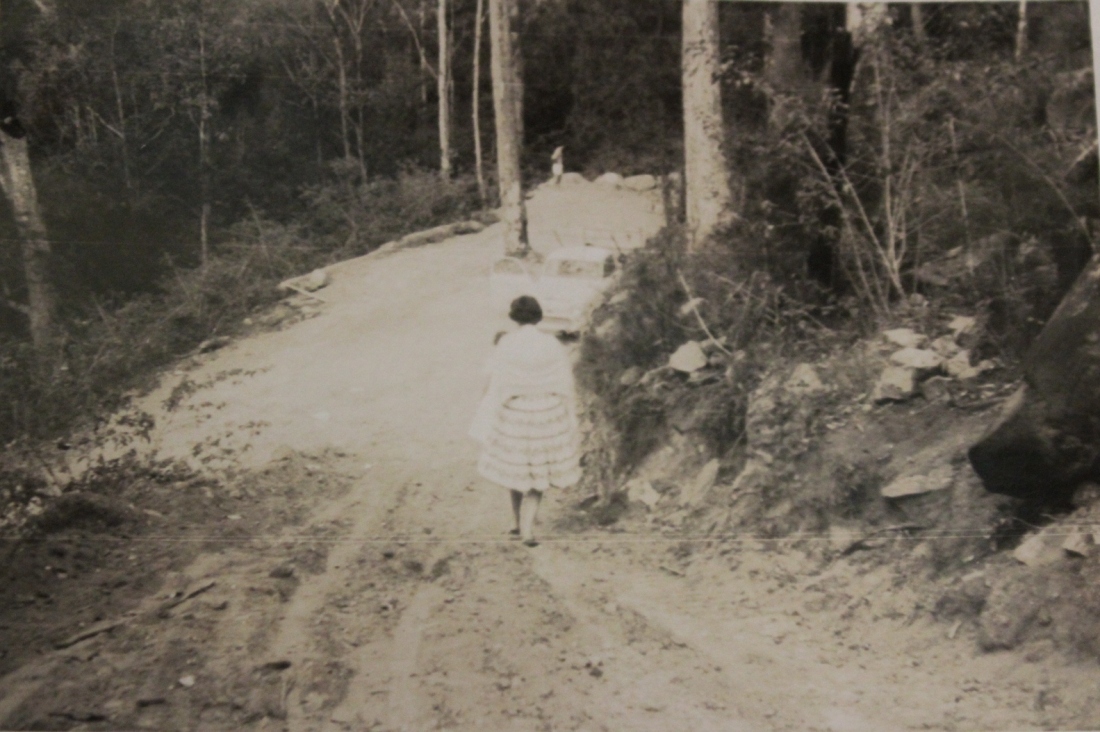
The Lyalls first block in Herbert Avenue, Newport, 1961 - David Lyall photo
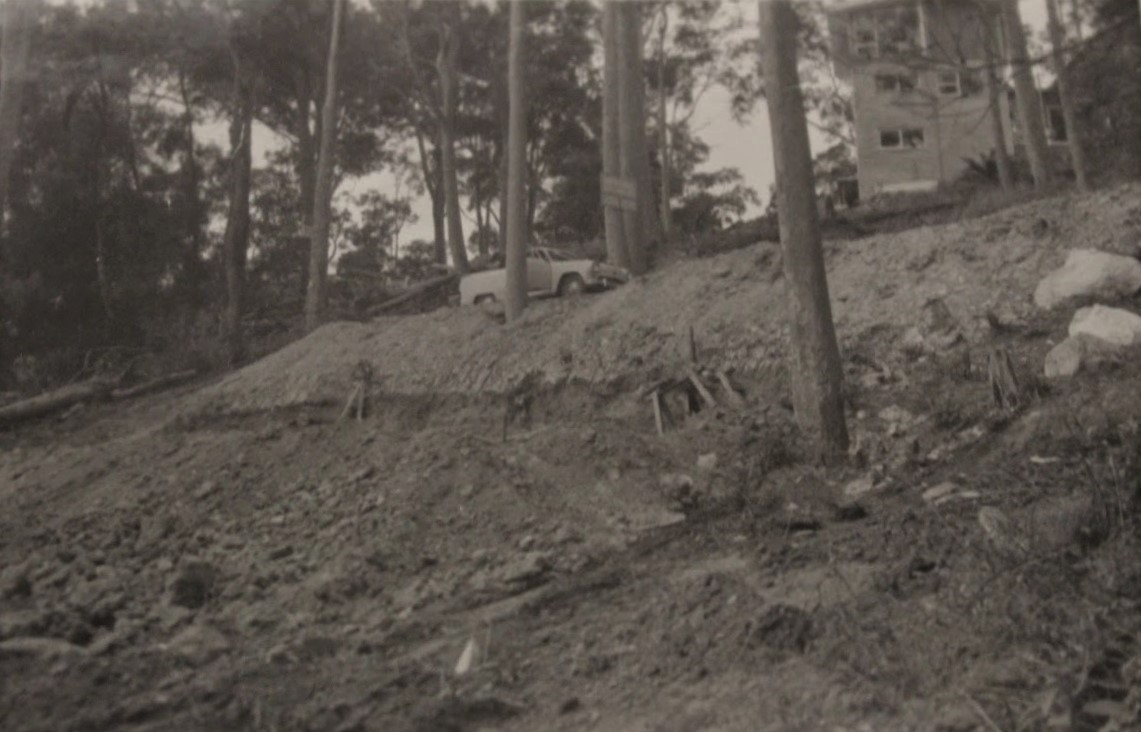
David's Trappers Way build site - circa 1961-1962, David Lyall photo
How much was the block of land then?
David: 3 thousand pounds.
It went up quite dramatically quite quickly then?
David: yes.
Phyllis: my friends who were married in 1951, and didn’t go overseas, they bought land then for 500 pounds. So it did go up quite quickly.
David: Trappers Way is also a story in itself. The subdivision was started by ‘Trapper’ Stapleton who got his nickname from when he enlisted to join the army. He was asked what his occupation was, to which he answered ‘rabbit trapper’ and then carried the nickname of ‘Trapper’.
When this subdivision was created it got the name of ‘Trappers Way. Stapleton park, or reserve, is right up the top here.
There are 52 houses in this subdivision.
Phyllis: we’ve been best friends with the lot of them but we’re one of the four original home builders.
Didn’t he have a home just along here too?
David: yes, just around the corner – Kooka Cabin that was called. He was a very interesting man.
So you were building?
Yes, I started out as David Lyall, Builder and Contractor. The first house I built was right on the corner of Porter Reserve – that first house as you come up the hill into Bilgola.
The firm then grew and I became D L Constructions Pty. Ltd.
The firm became bigger and bigger and I built the first completely precast building in New South Wales at Manly. We put that up in 42 days. It’s still there – looking up the harbour.
At the same time I built The Spit Marina, which is still there on the western side of The Spit at Mosman.
I also got involved with a lot of products at that stage. First off with the bowling alleys, and a lot of this came with association with people at the surf club. For instance Jim Robinson Scott and I were involved with the precast work. That all evolved out of sitting on a boat, quietly sailing somewhere, or pretending to be racing, with the Manager of EBM Concrete, a Structural Engineer, the head of ARC, the reinforcement people, and myself as a Builder. We built that, as well as a couple of other precast buildings.
I then got involved with Ampol and ended up doing the first of the modern-grass tennis courts, the artificial grass versions.
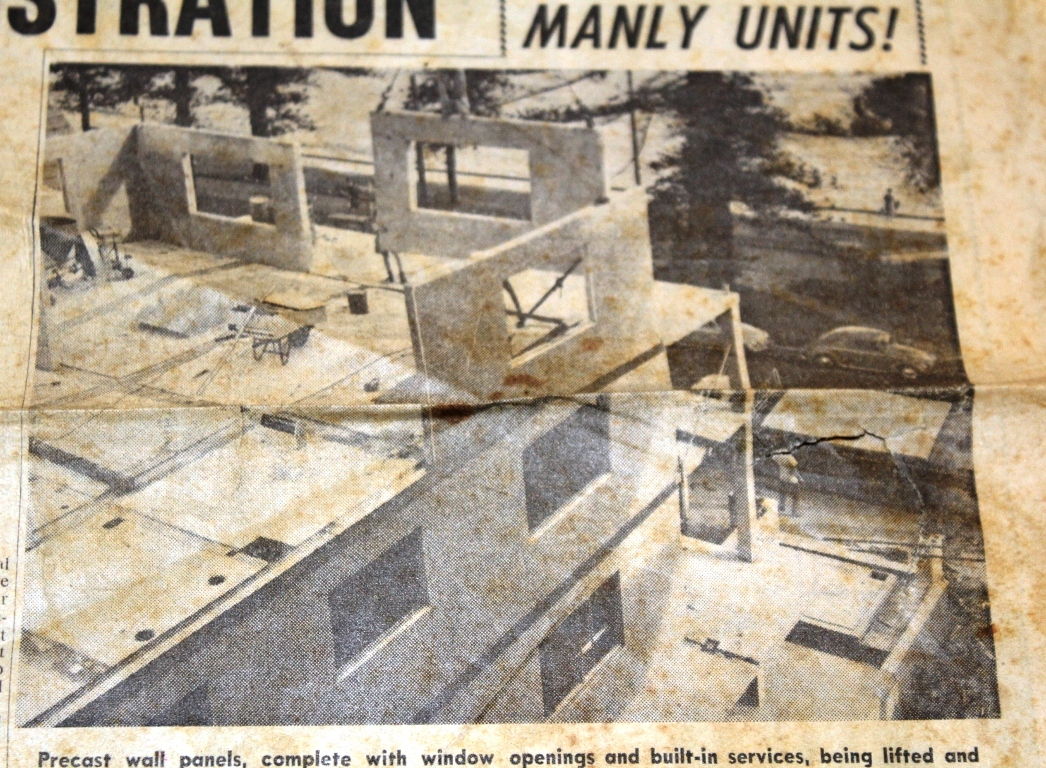
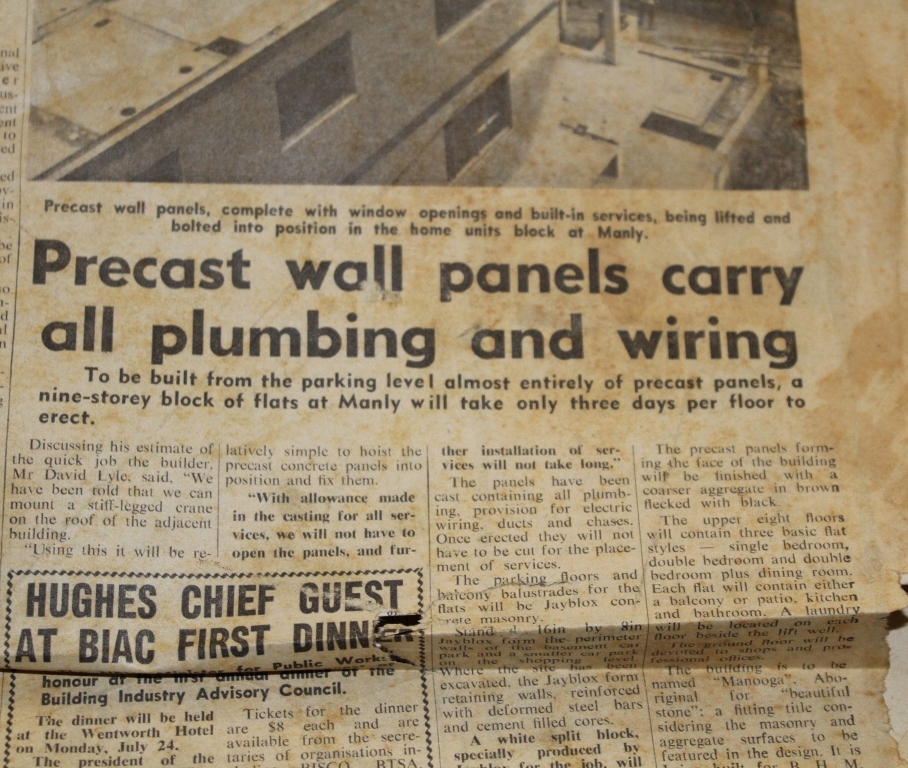
May 23, 1967 article from Construction
Why are you attracted to all these innovations?
Because people would ask me to solve the problems. They couldn’t find anyone else to solve the little problems each had along the way and would come to me and ask me to – so I did.
At that stage a client I was building a lot of units for – I did about a thousand units down in Dee Why and Narrabeen and so forth – bought land up in Coolangatta. So I created another firm up in Queensland and had a whole team working there, as well as the team here. I ended up building the first high-rise at Broadbeach. This was eight stories high; nowadays they are 80 stories high.
Then in 1989 we had a really bad downturn in the Building Industry, none of my sons wanted to go into the firm, so I closed the firm down. I found jobs for everybody that worked with me and then joined Local Government.
On Local Government I became a Project Manager and my job was to look after building all the things that council wanted built at the time – St. Ives showground buildings, etc.
In 1991 when residents had finally gained the right to split from Warringah Council, I was seconded out of Warringah two months before Pittwater was formed and my job was to set up and create Pittwater. So I had to set up all the infrastructure for Pittwater and move everybody over from Warringah to Pittwater.
It wasn’t a happy split. There were some bad discrepancies of charges levied at the new council. At one stage, just to try and stop or end this, I was moving people into Vuko place at Warriewood and had them sitting on packing cases rather then keep up the charges being levied to have them sitting in Warringah offices unable to anything.
The main desk for Pittwater Council when we started was trestles with a rug over the top of it.
That was possibly one of the hardest jobs I did and I give credit there to all the line managers – these blokes worked their guts out to make it work. It was a success, we created a great council, which won the Bluett award. Up until two years ago we were the most financially viable council existing. Now all that money saved and well managed has been taken.
Some of the works I recall during that time was we had to do a complete rebuild of the Narrabeen Caravan Park – we had only x amount of weeks to do this or it was going to get closed. Luckily I had a gentleman named Chris Guy who helped me with this and we got it done to the day.
On top of that, in 1994 I was on a committee called the Access Committee as part of Pittwater Council. Our job was to make things better for people with disabilities. One of the chaps said we had big problems with the disabled toilets; if someone vandalises them or damages them it causes problems. So we invented what was called the MLAK Key – Master Locksmiths Access Key. That key is now universal in the whole of Australia and New Zealand. If you go to a disabled toilet you will see a little blue outline of a Yale key and that symbolises an access key. I still have key number 3 – for my birthday 3-3-33!
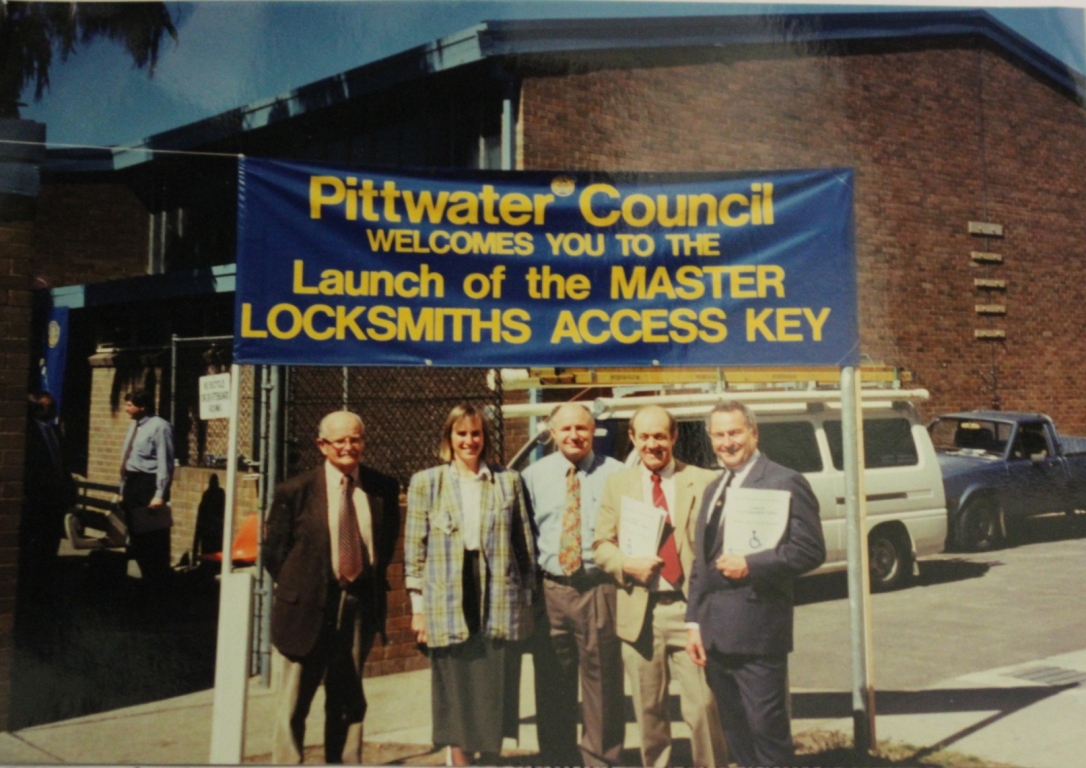
The MLAK Launch, September 1994; The Pittwater Access Committee
That, and a few other things I’d done, like the apparatus for lifting disabled people out of wheelchairs into Sailability boats, must have caught the attention of someone because the next thing I know I’m being awarded the Public Service Award.
That was a very prestigious medal then – there were only two given that year.
Phil; when I met David his mother told me he doesn’t have a lazy bone in his body.
I got involved in the 1960’s with the Australian Institute of Building, which is the academic side of the Master Builders. I rose through the ranks of the Institute and became the President of New South Wales and also a Councillor on the National Council for Australia.
Phil and I used to go down to Canberra every three months.
I was actually involved during this time in creating what is now known as The Building Code of Australia. We developed that out of what was called ‘Ordinance 71’.
The Building Code when we developed it was about that thick (indicates two inches). We then put it out to all the states with a request to add their addendums.
It’s now that bloody thick (ten inches or more).
They decided I must have done some good as they made me a fellow of the Institute.
So that’s the other letters after my name FAIB – Fellow of the Australian Institute of Builders.
I was still at Pittwater council under Angus Gordon GM and doing all the leases for the various clubs etc. in 1999, which was really a landmark structure that was then copied by others. We came up with a community net benefit lease which has since become practise for all the surf clubs.
This and the MLAK Key are just two instances of innovations that came out of Pittwater council and its ethos that have since become standard practices for many right across the board.
Let’s talk about Marine Rescue – in 2015 you were awarded a Maritime Medal for numerous maritime volunteer roles including being a Volunteer with Marine Rescue. How did that begin?
This again was a progression over many years. I’m a Life Member at Avalon Sailing Club, was President and Commodore there for many years as well as sailing that’s our boat there – the Red Herring.
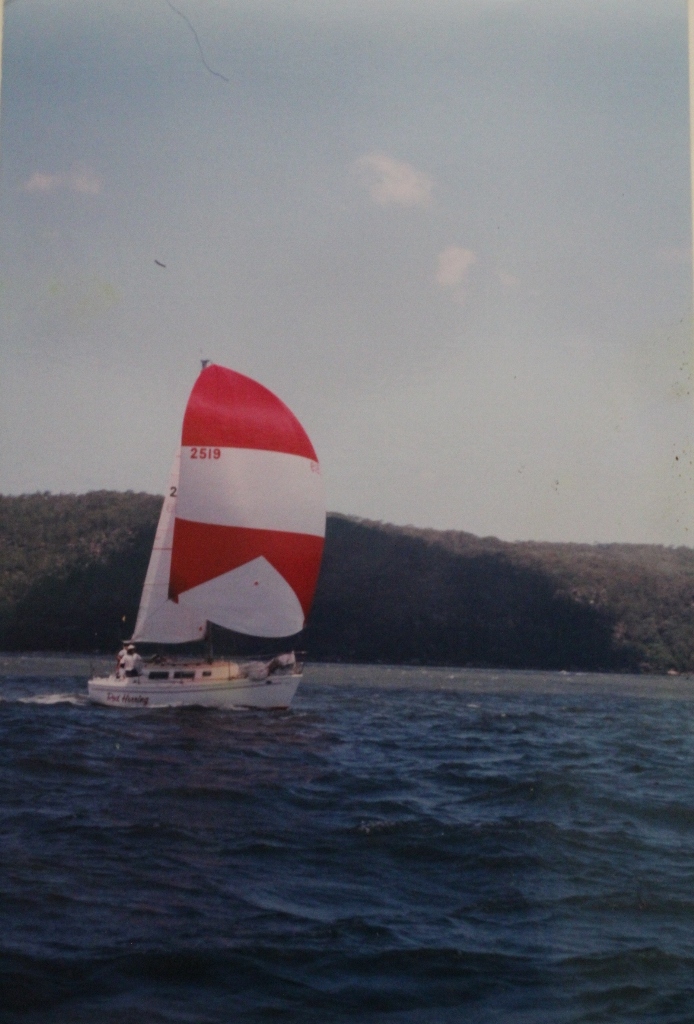
The Red Herring
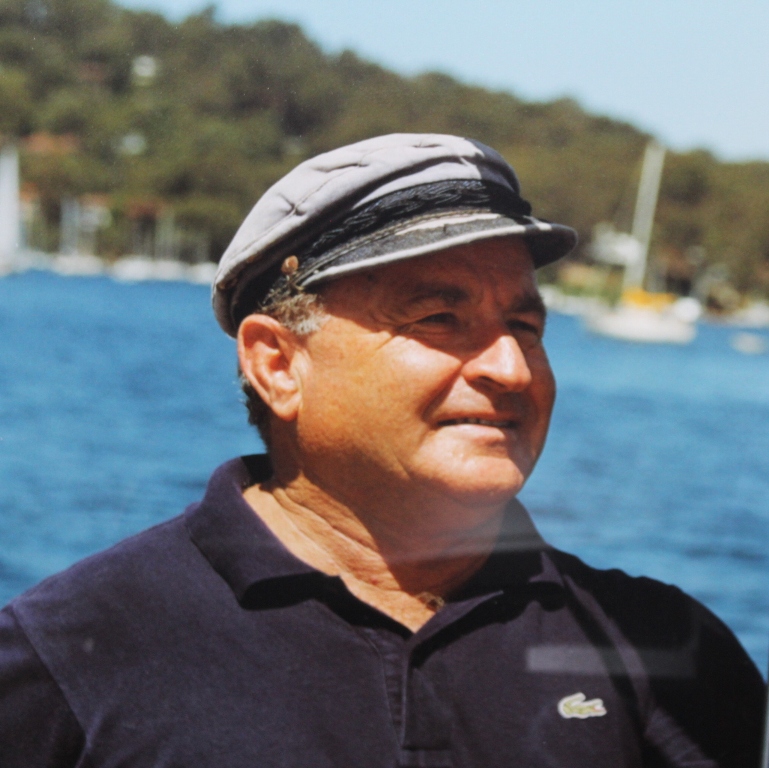
The Skipper of the Red Herring
At one stage I was Training Officer down there and took a lot of interest in training people. I still have all those qualifications and can train and examine for keel boat, sailing and yachting.
Because of that involvement on the water I then got involved, with Michael Chapman, in the Boat Owners Association and ended up vice-president and with a Life Membership. Through Michael and my involvement with the Boat Owners association we heard of the discussions to amalgamate all the rescue groups. Michael and I got involved with the formation of Marine Rescue long before that started. In the background, and not taking a lead, but being very much grass roots organisers.
With the background of the leases structure we’d done for Pittwater council – 146 leases and licences later….
I redid all the leases and licences. There were also 50 communication towers that need rejigging too.
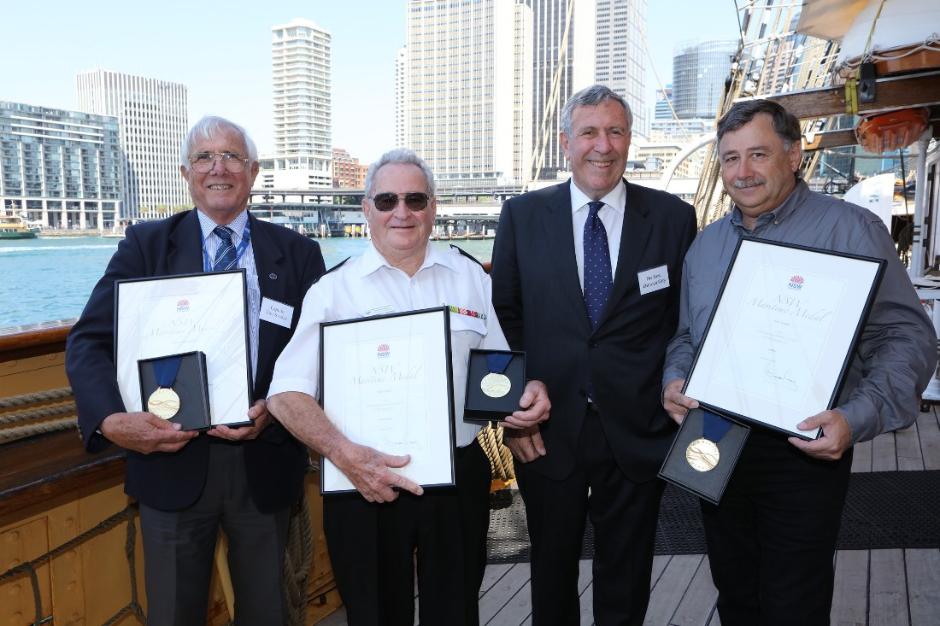
(L-R) 2015 NSW Maritime Medal recipients Captain Tim Swales (Community Medal), David Lyall (Community Medal), Minister for Roads, Maritime and Freight Duncan Gay and Peter Hunter (Safety Medal) on board the James Craig tall ship.
So it was a well earned, once again medal – the Maritime medal?
That was a surprise to me actually. Phil reckons it’s the only time she has seen me at a loss for words.
That day was one of the funniest I’ve ever had. Neil Patchett from Marine Rescue opened the proceedings and there we all were, standing in the James Craig and he’d welcome everyone. Duncan Gray then turned up and after doing his formal introductions and acknowledgements then quipped, ‘and I’d also like to thank the other traditional owners of Circular Quay – the Obeid family.
We all cracked up – he was a great bloke in that role, a great bloke anyway, even without the politics.
So they gave me the Maritime Medal. One of my sons said ‘geez dad, not another medal!’
So I now have the National Service Medal, the Defence Medal because of CMF, the Emergency Service Medal, the Public Service Medal and the Pittwater Medal.
What was it like being awarded a Pittwater medal? – there’s not a lot of those that have been handed out.
I had an attitude when at council that I was there to help the people, the residents. I remember at one stage we had a meeting with the managers and directors and said; what we should be doing is each one of us take a turn on the Service Desk on the front counter for half a day to get some experience of how to do it better.
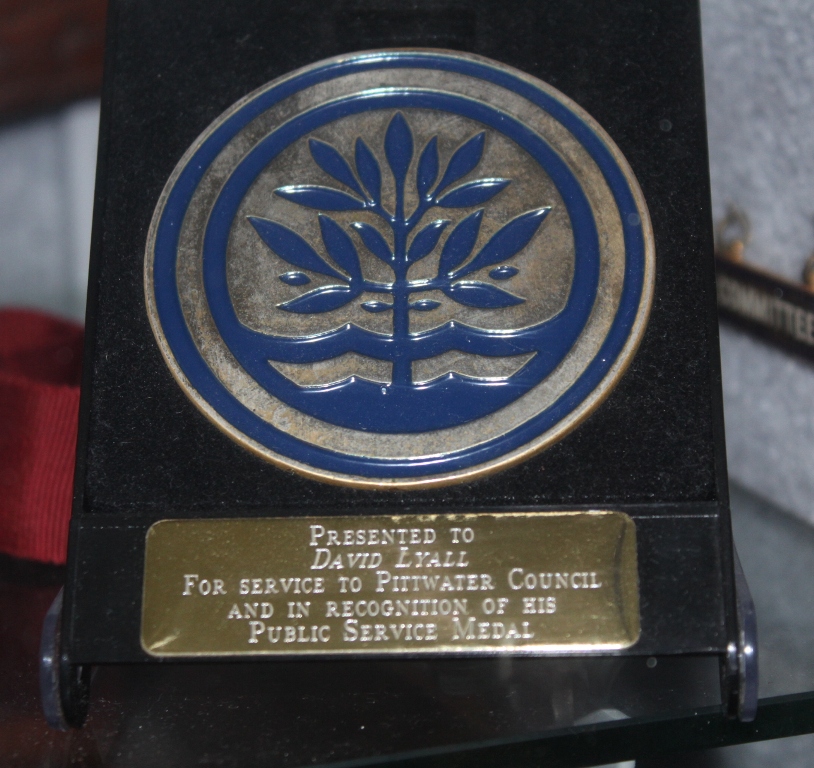
Retirement was a good idea then?
Don’t retire – you just get busier! I have all these wonderful old carpentry tools and am still making things. The last job I did was a clock from some beautiful old cedar.
Commencing in Bilgola Surf club and voluntary work still being done at present, there’s almost 70 years of serving the community. Where does that come from?
I don’t know. From an early age I just wanted to help people. If somebody asked for something if I could do something for them I did.
The other day a friend of Phyllis said ‘I’m looking for a new coffee table but I can’t find one suitable’. So Phil got into my workshop and I rebuilt it for her.
Out sailing yesterday one of the blokes has a problem with his vanity unit; so I got the number for a good plumber for him and away he went.
When you were building – what was you favourite project, which are you most happy about?
I think the one that strikes me the most in the waterways was the spit Marine, because that was the first floating marine in New South Wales.
Building wise; I built 48 units over the top of the headland at Curl Curl – I was very proud of those.
When in Council – probably the Avalon Community Centre.
Among those there were some unusual ones too though – I built a rural fire services building over at Mackeral Beach in the middle of the road.
When was that?
Around 1990. There was nowhere else to put it – it would have been in the swamp otherwise.
There’s some funny stories – I remember we went through a stage where people who owned homes at Sand Point at Palm Beach were running out after every storm to put grass seeds in the sand that would end up there as they could then extend their properties as they owned to the high tide mark. Word got around and the people over at Mackeral said; ‘look we know where it came from and we want it back.’
Peter Verrills is the man to talk to about some of those Palm Bach stories – he’s a character.
I remember during the 1994 fires when a lot of people were away from council and I had to do something to look after those offshore, it was getting pretty bad. I rang Peter and said, ‘look mate, I think we’re going to have to evacuate Mackeral – can you get your boats over there?’ to which he replied; ‘I’m already here mate.’
(laughs)
Those 1994 fires – I remember on the Friday I said to my blokes; you better stand by, we may be in for a bad weekend. I ended up down at the Pittwater Quays depot, which was my command centre later that Friday. We were on the whole weekend. By the Sunday everyone’s dead on their feet and were down at Rat Park putting up compounds for all the horses we were bringing out of Terrey Hills. My painter, Ross Hennessey, another real character, he was there when one of the mangers of the horse park marched up and demanded if Ross knew anything about horses; ‘no mate, but I have seen The Man From Snowy River I and II’.
What is this project where you’re halfway down a cliff?
That was at South Head. We had to install that great light for the University of Sydney and climbing down that cliff was part of it.
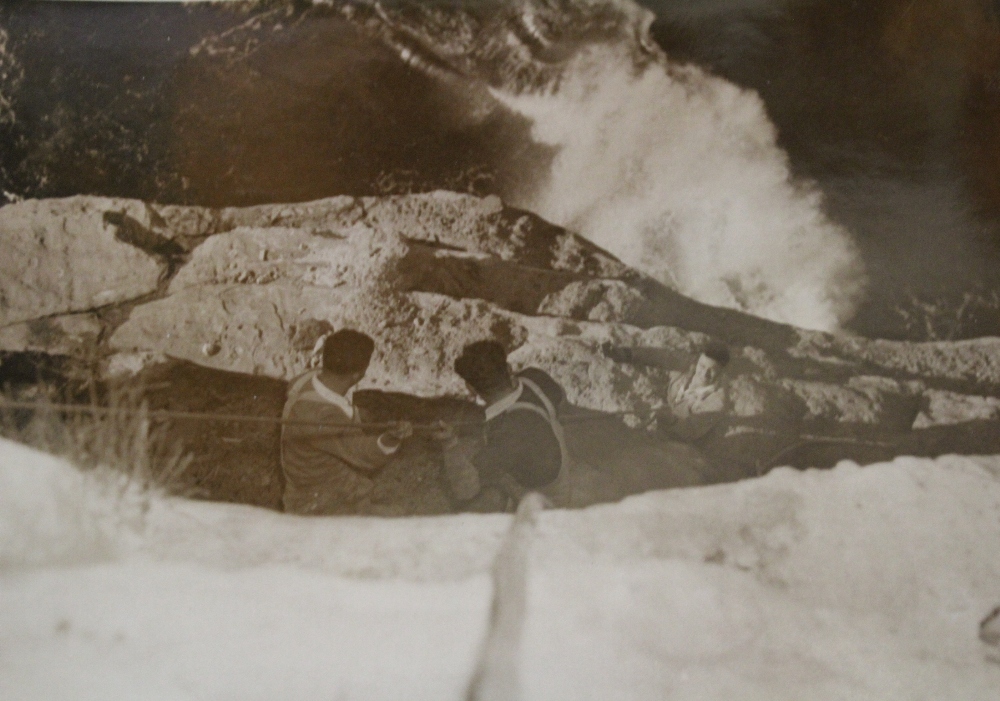
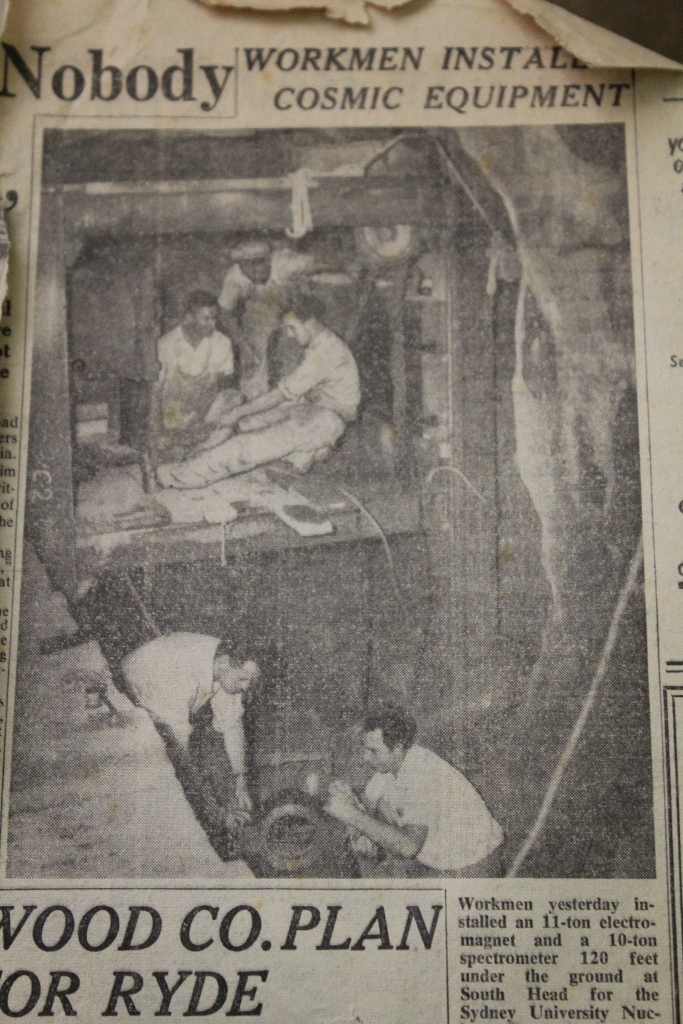
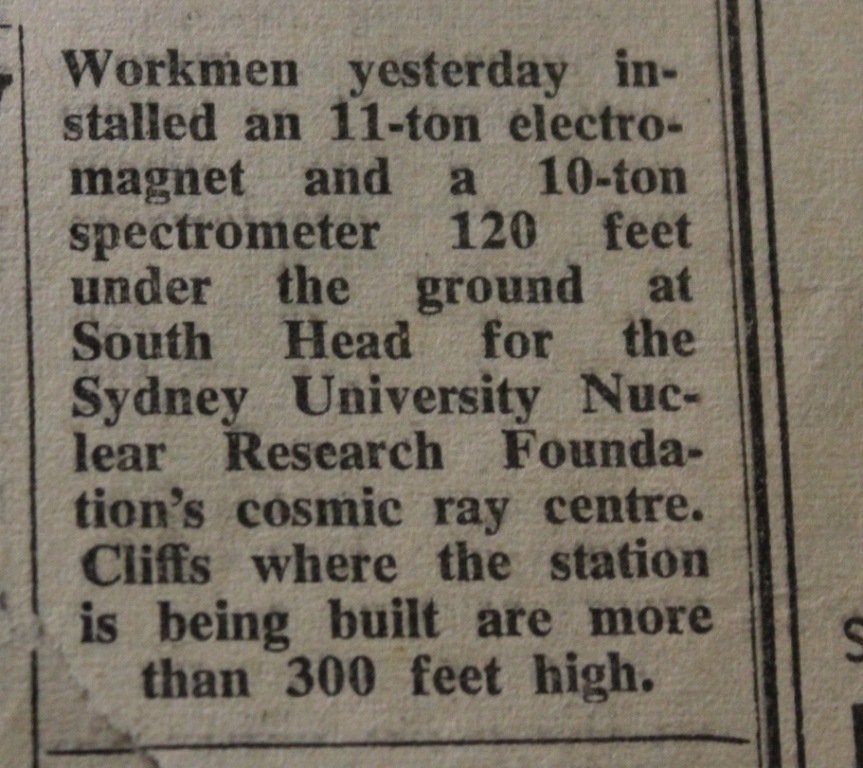
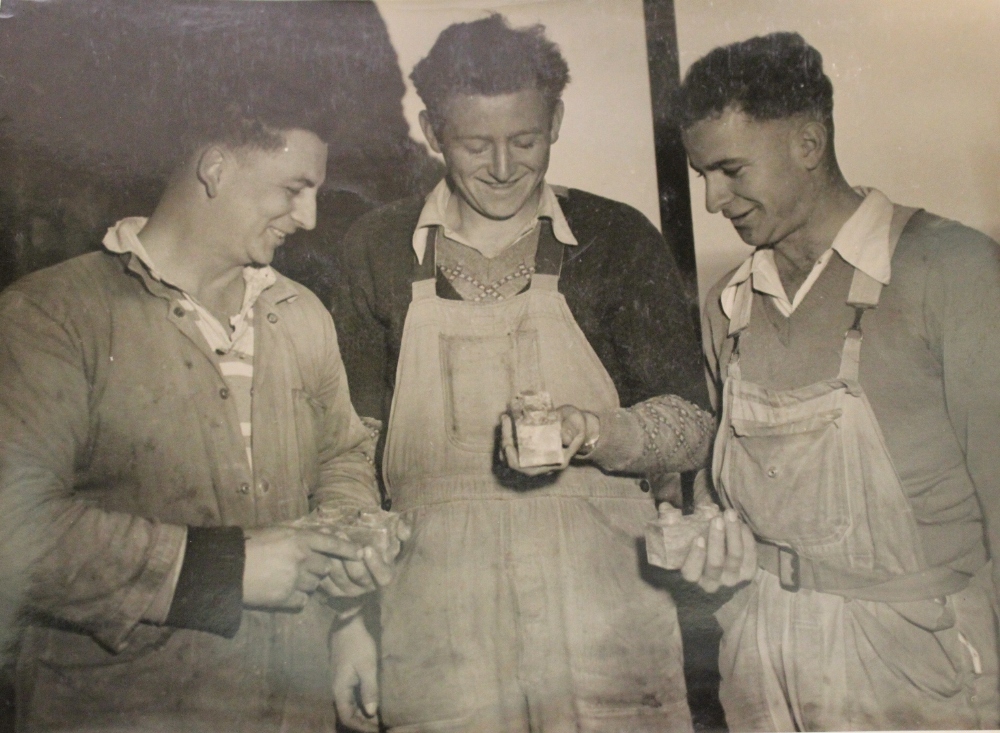
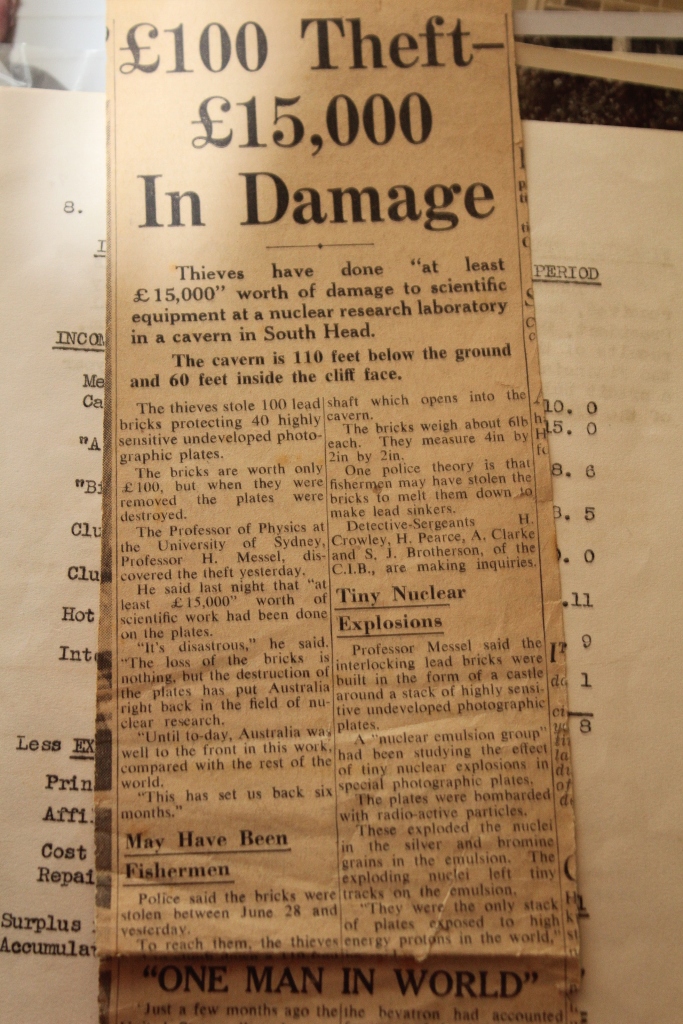
Your Sons: Scott, Ian and Tim – are they still living locally?
No, one is at Alexandria and works out at the Western Sydney University, one is in the Fisheries Department, Manager of Aquaculture at NSW DPI. He’s been working on that kingfish farm set off Port Stephens. Around 20 thousand of them escaped in rough seas in January this year – and 3000 came back in to be fed!
The other is in London working as a Line Producer in film.
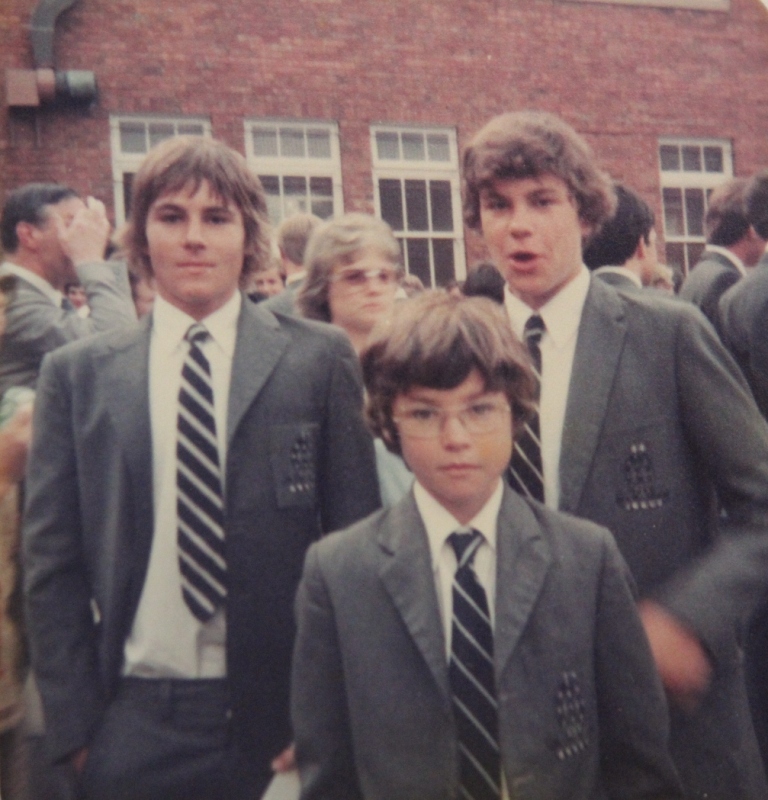
What are your favourite places in Pittwater and why?
My home, because it has everything that I would wish to have. In boating it would have to be Castle Lagoon, because it’s a fun little place to stay overnight without being disturbed by the wash from other vessels.
What is your ‘motto for life or a favourite phrase you try to live by?
Do unto others as you would have them do unto you.
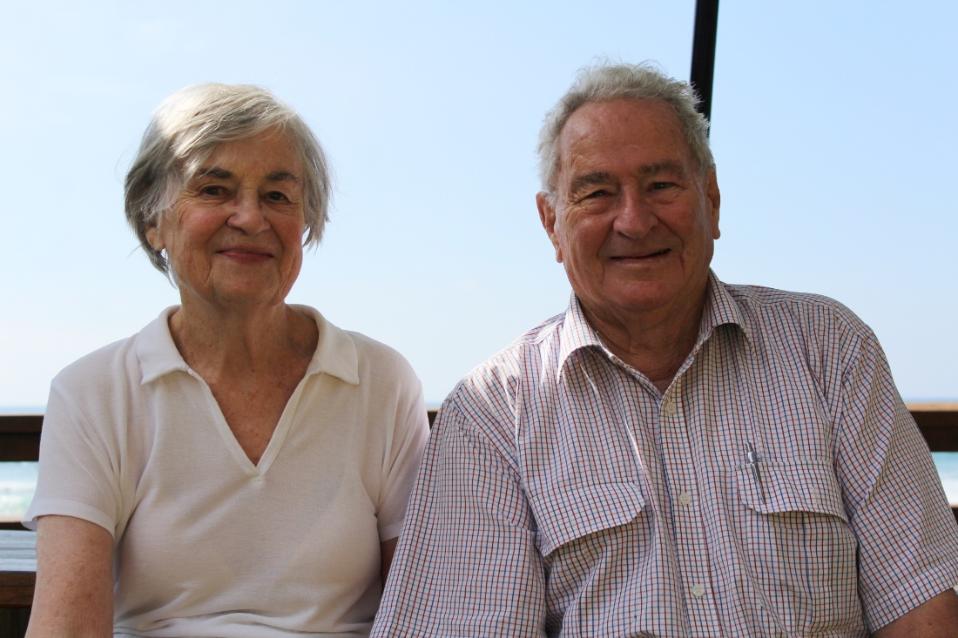
Phyllis (Phil) and David Lyall